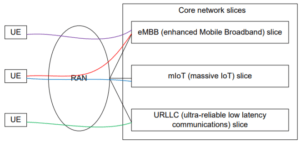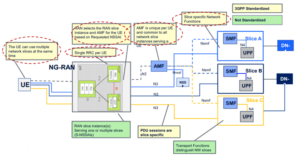Introduction
The Network Slicing (NS) concept is an essential factor for 5G to provide different vertical industries with different service needs, in terms of capacity, latency, reliability, and domain-specific extra functionalities.
5G also identifies the need to provide use cases such as enhanced mobile broadband (eMBB), ultra-low latency communication (URLLC) and massive-IoT (mIOT) services and in combination with Network Slicing, It permits business customers to enjoy connectivity and data processing suited to their specific business requirements.

Source: 3GPP
What is Network Slice (NS)?
From the MNO (Mobile Network Operator) perspective, a network slice is an independent end-to-end logical network that runs on shared physical infrastructure, capable of providing an agreed QoS (Quality of Service).
The Network Slice (NS) is including Radio Access Network (RAN) and Core Network (CN). It provides different telecom services and network capabilities, which may be different from slice to another slice. A device may have the capability/need to access different Network Slices at the same time through a single RAN.
The Network Slice (NS) comprises dedicated and/or shared resources, e.g. in terms of memory storage, power, and bandwidth and has isolation from the other network slices. The operators will have the capability could to deploy a single network slice type that satisfies the needs of different verticals, and in addition multiple network slices of different types that are wrapped as a single product targeted towards business customers (a business bundle) who have multiple and diverse requirements (for example a vehicle may need simultaneously a slice with high bandwidth for infotainment and another slice with ultra-reliable feature for assisted driving).
Network slicing targets transforming a PLMN from a single network to a network where logical separations are created, with proper network isolation, resources, optimized topology and specific configuration to serve different service requirements.
5G Network Slicing Definitions
- Network Slice: A logical network that provides specific network characteristics and capabilities.
- Network Slice instance: A set of network functions, and resources to run these network functions, forming a complete instantiated logical network to meet certain network characteristics required by the Service Instance(s).
- Network Slice Type: Network slices are categorized into different types according to the abstraction of characteristics of the services they facilitate.
The system used for defining network slice types is different for the network slice provider. Some typical examples of network slice types according to 5G implementation include eMMB, mMTC, and URLLC. - Network Slicing provider: Typically a telecommunication service provider, is the owner or tenant of the network infrastructures from which network slices are created. The Network Slicing provider takes the responsibilities of managing and orchestrating corresponding resources that the Network Slicing consists of.
- Network Slice Terminal – A terminal that is network-slice-aware, typically subscribed to the service which is hosted within a network slice instance. A network slice terminal may be capable of subscribing to multiple network slice instances simultaneously.
- S-NSSAI – single network slice selection assistance information
- SST – slice type, describes expected network behavior
- SD – slice differentiator, optional, further differentiation
Identification and selection of a Network Slice
Network Slice definition is done via the Single Network Slice Selection Assistance Information (S-NSSAI).
The NSSAI (Network Slice Selection Assistance Information) is a collection of S-NSSAIs.
Currently, 3GPP allows up to eight (8) S-NSSAIs in the NSSAI sent in signaling messages between the UE and the Network. This means a single UE has the capability to be served by at most 8 Network Slices at a time.
The S-NSSAI sent by the UE to the network, assists the network in selecting a particular Network Slice instance.
An S-NSSAI is comprised of:
- A Slice/Service type (SST), which refers to the expected Network Slice behavior in terms of features and services; 3GPP defined some standardized SST values in TS 23.501. These SST values are to reflect the most commonly used Slice/Service Types and will assist with global interoperability for slicing.
- A Slice Differentiator (SD), which is optional information that complements the Slice/Service type(s) to differentiate included in multiple Network Slices of the same Slice/Service type.
The S-NSSAI may be associated with a PLMN (e.g., PLMN ID) and have network-specific values or have standard values. An S-NSSAI is used by the UE in an access network in the PLMN that the S-NSSAI is associated with.
Standard Slice Type (STT) Values
SA2 has defined some standardized SST values in TS 23.501. These SST values are to map the most commonly used Slice/Service Types and will assist with global interoperability for slicing.

Source: 3GPP TS 23.501
Core Network Slicing
Different use cases may have different functional requirements and performance requirements. But the current network is a ‘one size fits all’ system.
When a new use case is deployed, in order to fulfill its requirements, multiple network functions have to be updated and new network functions have to be deployed. So the network becomes larger and larger and hard to manage and update.

Core Network Slicing
E2E Network Slicing in 5GS
The concept of network slicing was proposed for the 5G core network (CN). By exploring software-defined networking (SDN) and NF virtualization (NFV) principles a fully virtualized CN instance optimized per business purpose could be defined.
The network slicing primarily targets a partition of the CN, but it is not excluded that RAN may need specific functionality to support multiple slices or even partitioning of resources for different network slices”.

Source: Nokia
Challenges in Network Slicing
Some challenges in NS are issued by Nokia like:
- Complexity– As multiple domains need to work together to implement E2E slicing.
- Many aspects are not standardized – choice among solution options.
- Acceptance of cloud architecture.
- Service infrastructure.
- Security considerations.
- Commercial aspects.
5G Network Slicing Trails
There’re different trails in the domain of Network Slicing targets testing the performance and the capability via the 5G Network, these trails were done by many vendors and operators.
In October 2015, Ericsson and Korean operator SK Telecom demonstrated 5G network slicing technology at SK Telecom’s corporate research and development center in South Korea.
The demonstration targets the creation of virtual network slices optimized for services including augmented reality/virtual reality, massive “Internet of Things” offerings and enterprise solutions.
Huawei and Deutsche Telekom also demonstrated a 5G end-to-end network slicing capability during this year’s Mobile World Congress.
The 5G NS demo was conducted in DT’s 5G lab based in Germany.
Conclusion
In the 5G era, discrete industry verticals need to weight the technology power to improve productivity across the globe sectors, So Network Slicing and service function chaining are functional attributes that are key for 5G. Currently, Network Slicing exist in 4G and can enable a smooth migration to 5G.
Resources
- NGMN Alliance, “5G White Paper”, February 2015.
- Ericsson, “5G Systems White Paper”, January 2015
- Ericsson, “The Real-Time Cloud White Paper”, February 2014
- 3GPP TR 22.891, “Study on New Services and Markets Technology Enablers”, September 2015.
- 3GPP S2-153651, “Study on Architecture for Next Generation System”, October 2015.
- 3GPP TS 23.502 – 5GS Procedures
- 3GPP TS 23.501: “System Architecture for the 5G System”













